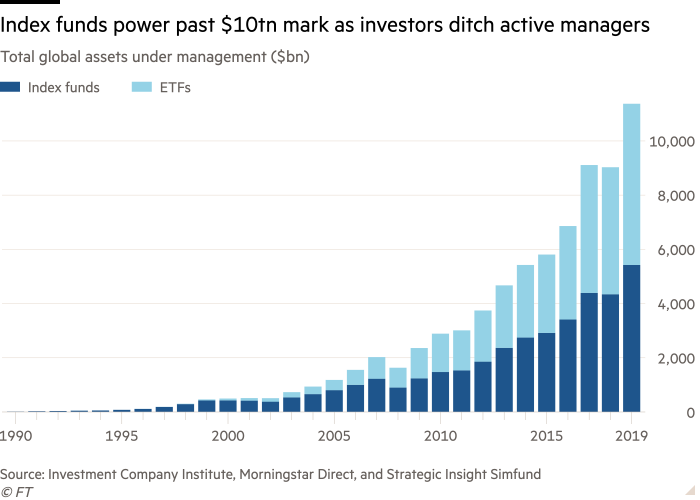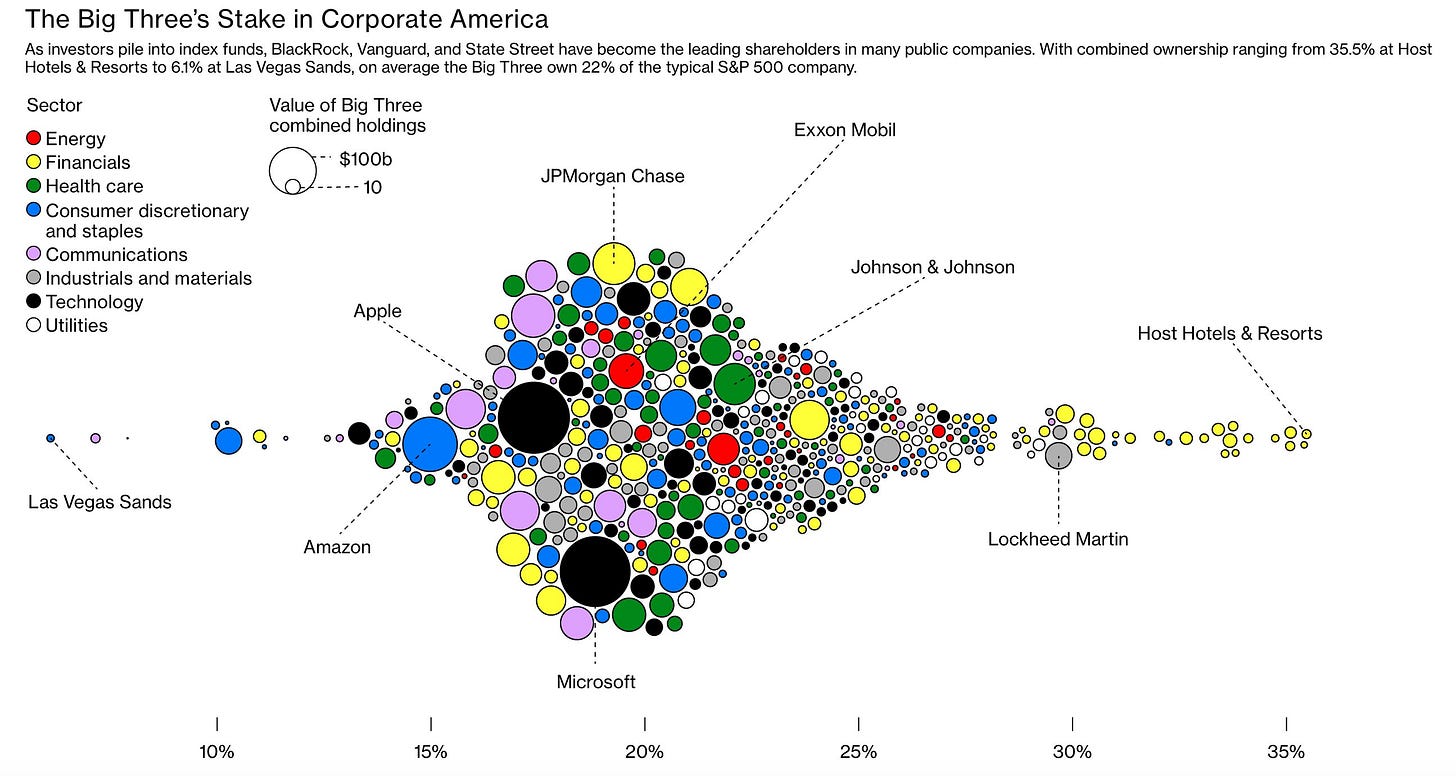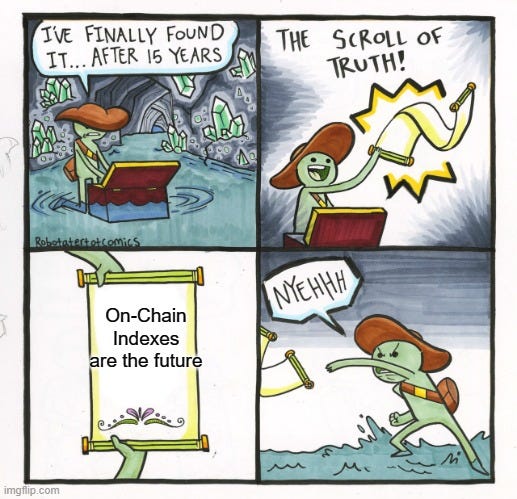On-Chain Crypto Index
How crypto will reach $10 trillion in market cap.
Disclaimer, NFA, all that legal stuff: All the information presented on this publication and its affiliates is strictly for educational purposes only. It should not be construed or taken as financial, legal, investment, or any other form of advice.
Hi folks,
Monday was US labor day, so I gave myself one extra day to write this issue. Somewhere in the East this issue is still being sent out on September 7th, so I’m technically not late — if that sounds like an excuse, trust your instinct. It has been a fairly slow week in crypto despite the ongoing Ethereum merge, which is undoubtedly the most anticipated event in crypto, ever. I might write about it next week if I feel that I can still contribute something meaningful. Everybody and their mothers have been writing about it, so maybe what we need is an orderly summary instead.
Anyway, let’s get into this week’s topic: on-chain index. Much less sexy, but a key factor for crypto as an asset class to reach $10 trillion in the next cycle.
On-Chain Crypto Index
Indexing, or investing in a “basket of assets” within a specific set of rules, has been the number one investment trend in the past few decades. In 2020, the combined AUM of index funds reached $10 trillion. The big three index funds: BlackRock, Vanguard, and State Street managed a combined $22 trillion in AUM. The big three index providers, S&P Dow Jones, FTSE Russel, and MSCI facilitated a combined AUM of more than $40 trillion benchmarked to their indexes.
The ability to invest your capital within a set of frameworks or methodologies can go a long way. It provides investors with diversification and a cheaper cost as it doesn’t require active management from a team of overcompensated Wharton MBA graduates named Brad that spends his summer in Nantucket, but I digress.

Crypto is an inherently finance-first space as products can have tokens associated with them right off the get-go, unlike its counterparts in Web 2.0. This environment, while tricky to navigate, is poised for on-chain index providers to capitalize on. Blockchain technology makes the crypto market much more transparent and open, which are crucial elements for proper index constructions. Frankly, it is surprising that we haven’t seen much success in the on-chain indexing space. Or is it?
In this write-up, we present explanations of why on-chain indexes are struggling, their pros and cons, as well as their parts in the future of the crypto market.
Here are the quick takeaways:
Indexing has been the number one investment trend and crypto needs to embrace it if it wants to reach $10 trillion in market capitalization.
On-chain indexes are currently stagnating because they target the wrong crowd.
Smart contracts are suitable to automate index methodology on-chain, but require a robust framework and adaptability on the protocol level.
If governance functions as intended, on-chain index winners will become the BlackRock of crypto.
On-chain indexes lack distribution, which might require centralization tradeoffs to optimize.
Benefits & Challenges
The state of the on-chain index is subpar at best. The biggest player, Index Coop, has a combined AUM of ~$70M across all of its products. Other players, such as Amun by 21Shares do not even reach an AUM of $1M. It’s pretty clear that on-chain indexes have not thrived.

This is ironic because the primary strength of index investing can be distilled down to discipline. If you have a set of rules that you need to follow no matter what happens, you’re less likely to make ad hoc discretionary decisions based on emotions. This is especially beneficial in a market as volatile as crypto. Furthermore, the methodologies that are implemented by many index providers are suitable to be executed by smart contracts, requiring even less human involvement.
Imagine if the defipulse index implemented a methodology that takes into account the following metrics and automatically rebalances every month.
net protocol revenue
revenue shared with tokenholders
developer activities on GitHub
free float/circulating supply
yield opportunities
There is a multitude of ways an interesting on-chain index can be created without overly relying on market capitalization. Crypto as an asset class is already extremely correlated, rendering market cap-weighted indexes somewhat useless if you want to market your products to the crypto-native crowd.
On top of the typical benefits that an index provides, on-chain indexes are great because of their transparency and composability. Users can see exactly how the movement of assets underlying the indexes is being handled, which is practically a 24/7 audit trail. So why are on-chain indexes struggling?
It is simply that on-chain indexes are:
targeting the wrong crowd
not degen enough
lacking in distribution
Let’s break them down.
Targetting the Wrong Crowd. Interacting with an on-chain index means that the users are savvy enough to conduct on-chain transactions and participate in the DeFi ecosystem. These types of users are not considered 101-level market participants, which are primarily the target of index funds in TradFi. A finance major degree holder who’s working at Goldman is most likely not investing via index funds but is trying to manage her own money. Index funds are attractive for those who don’t particularly enjoy the nitty-gritty of capital markets and would rather delegate the decision-making process.
Not Degen Enough. Crypto users who are interacting with on-chain indexes are most likely degen enough to not care about buying something akin to the “top 10 cryptos large cap” indexes. They want to find the next crypto assets that can generate asymmetrical returns or would rather invest in MIM’s degenbox to lever up their stablecoin yield strategy 5x. Thus far, we’re not seeing any on-chain index providers that fill this need. Additionally, being in crypto means you’re already taking more risks than the average investor, which is rather antithetical to index investing.
Lacking in Distribution. TradFi index funds have brilliant distribution. Almost every individual has access to these funds either via retirement accounts, bank accounts, or others. In crypto, there are regulatory hurdles that the space needs to go through before on-chain indexes can have the same level of distribution. That said, there are crypto-native strategies for on-chain indexes to scale their distribution. This includes integrating with popular crypto wallets and exchanges — basically vertically integrating or partnering vertically as much as possible.
There are also regulatory issues to strategically navigate if the on-chain index providers have their own token, but that’s for another post.
Back to Governance
In my first-even post under this publication, I wrote about the token endgame, where I argue that the endgame for tokens is actually tokenized equities. That post was still my most viral post perhaps because I said the quiet part out loud. Based on that argument and if crypto governance truly works, then the on-chain index winners will become the BlackRock of crypto, having a lot of sway and power over many protocols.
For instance, BlackRock has been pushing its ESG agenda as the firm is a top-five shareholder in most S&P 500 companies, giving BlackRock significant voting power. Sounds familiar?

Given the recent drama and discussions surrounding DeFi 1.0 protocols, imagine if there’s an entity that’s so large and influential that they too can participate in these governance forums. Some would argue that it only complicates the situation, but others would say that it provides small tokenholders with more voice; if the on-chain index providers are properly representing their constituents.
Becoming a $10 Trillion Asset Class
Crypto is still a venture-first asset class. I can almost guarantee that most liquid-only (non-VC) active managers in crypto have not outperformed the broader crypto market in the past few years. However, if all things go well, crypto will mature and the asset class becomes similar to equities in the upcoming decade. When that happens, for crypto to continuously grow as an asset class, it needs a thriving indexing environment.
On-chain indexes are poised to capture this growth, so long as they can balance their growth and distribution strategy between institutions and crypto-native degens. Some sort of centralization trade-offs will be necessary in order to scale and compete with off-chain index providers. The firms that manage to get it right and capture growth on the institutional and crypto-native side will eventually win.
Content Creation
I’m learning to better manage my time around content creation. I love creating content because it seems like somebody out there feels like what I have to say is valuable, or maybe I’m just a narcist. Last week, I got a DM from a random person saying that he/she enjoys my weekly post. That made me happy. I’m also very into the creator economy and internet culture in general, which I’ll prove with upcoming posts. Trust me when I say that I’m really into it, and not just another web 3.0 VC pontificating the importance of music NFTs. Have they even heard of shitcamp?
Until next time,
Marco M.




I like it too, I also subscribe to the post, please keep writing